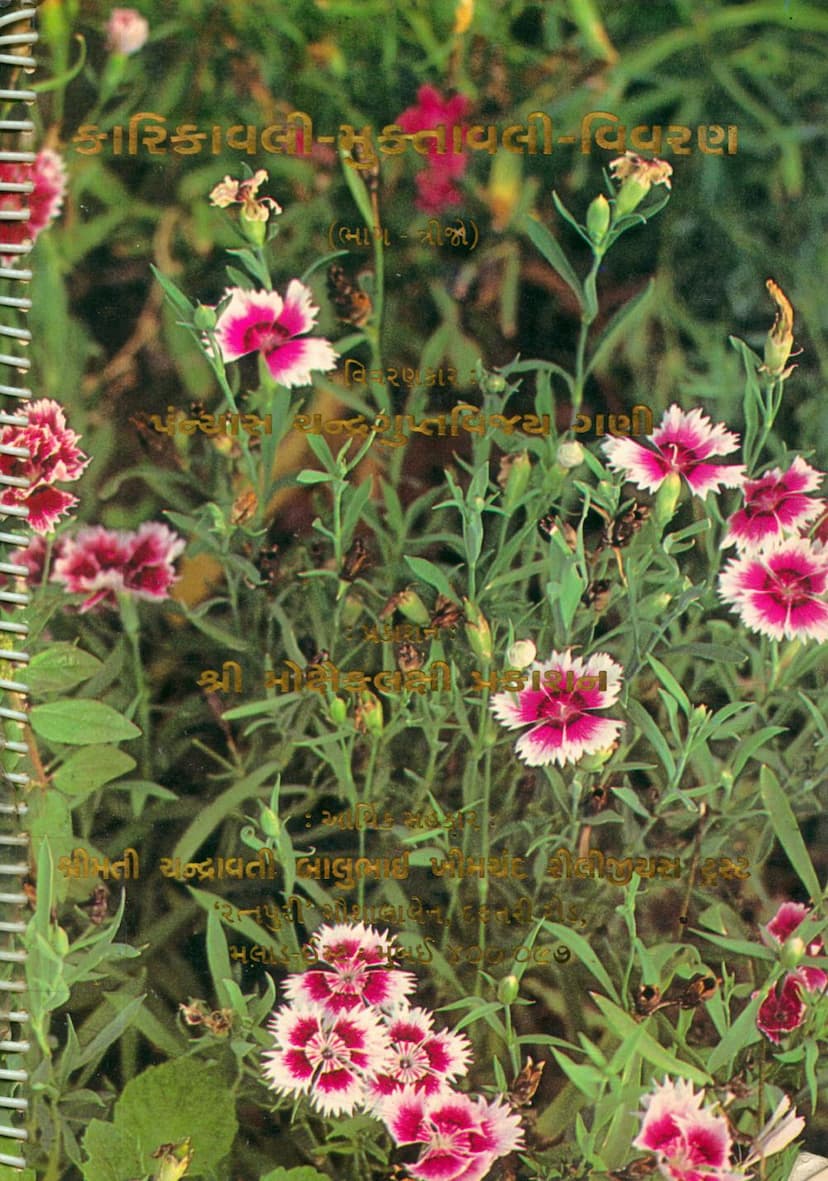Karikavali Muktavali Vivaran Part 03
Added to library: September 2, 2025

Summary
This document is a detailed commentary (Vivaran) on the Muktavali, which itself is a commentary on the Karikavali, a foundational text in Jain philosophy, specifically focusing on its metaphysical aspects. The commentary is attributed to Muni Chandraguptasuri and was published by Mokshaiklakshi Prakashan. This is the third part (Bhag - Trtijo) of this work.
Here's a breakdown of the key topics covered in the provided pages, based on the text and its commentary:
Core Subject: The Nature of Qualities (Guna) in Jain Metaphysics
The work systematically analyzes and defines various categories and qualities (Guna) according to Jain philosophy, drawing upon the Karikavali and Muktavali, and providing detailed explanations and justifications.
Key Concepts and Categories Discussed:
-
General Definition of Qualities (Guna Samanya Lakshana):
- The text begins by establishing the criteria for something to be classified as a quality. It emphasizes that qualities are dependent on substances (Dravyaashrita) and are devoid of action (Nirguna, Nishkriya).
- The commentary clarifies the nuances of these definitions, particularly "Dravyaashrita" (dependent on substance) to avoid over-extension to other categories like action. It also explains why "Nishkriya" (actionless) is a characteristic, not a strict defining feature.
-
Categorization of Qualities:
- Corporeal/Material Qualities (Murt Guna): The text enumerates qualities inherent in material substances. These include:
- Form (Rupa)
- Taste (Rasa)
- Smell (Gandha)
- Touch (Sparsha)
- Oneness (Ekatva - number)
- Magnitude (Parimana)
- Separateness (Prithaktva)
- Connection (Sanyoga)
- Disjunction (Vibhaga)
- Directionality (Paratva, Aparatva - relative position in space)
- Viscosity/Fluidity (Dravatva)
- Heaviness (Gurutva)
- Oiliness/Stickiness (Sneha)
- Velocity (Vega)
- Persistence/Elasticity (Sthitisthapaka)
- Apurva (unseen merit/demerit, though sometimes classified separately)
- Shabda (sound)
- Immaterial Qualities (Amurta Guna): These are qualities that do not reside in material substances. They include:
- Merit and Demerit (Dharma, Adharma) - related to virtue and vice, driving souls and matter.
- Impression/Mental State (Bhavana)
- Intellect/Knowledge (Buddhi)
- Happiness (Sukha)
- Unhappiness (Duḥkha)
- Desire (Iccha)
- Aversion (Dvesha)
- Effort/Action (Prayatna)
- Samskara (impressions, latent tendencies)
- Qualities residing in multiple substances (Anekashrita Guna): These are qualities like Connection (Sanyoga) and Disjunction (Vibhaga), and numbers like two, three, etc. (Dvitva, Tritva, etc.).
- Qualities residing in a single substance (Ekaikavrittaya Guna): The remaining qualities are typically considered to reside in a single substance.
- Corporeal/Material Qualities (Murt Guna): The text enumerates qualities inherent in material substances. These include:
-
Detailed Exposition of Specific Qualities:
- The work goes into considerable detail explaining each quality, including its:
- Perceptibility: Which sense organ perceives it (e.g., form by sight, sound by hearing, touch by touch, taste by tongue, smell by nose).
- Causation: How it comes into existence (e.g., some qualities are inherent/eternal, others are generated by causes like 'pakaja' - produced by cooking/heat, or 'karmaja' - produced by action).
- Characteristics: Its specific attributes and behavior.
- Eternity/Non-eternity: Whether the quality is eternal (Nitya) or non-eternal (Anitya), often tied to the eternity of the substance it resides in.
- Relationship to other categories: How qualities interact with substances, actions, universals, etc.
- Examples: The text uses examples from the physical world (like colors, tastes, smells, physical actions, heat, fluidity) and also from more abstract concepts (like merit, demerit, knowledge, desire, aversion) to illustrate the definitions.
- The work goes into considerable detail explaining each quality, including its:
-
Specific Topics and Debates:
- Causality of Qualities: The text delves into discussions about the types of causes for different qualities, including primary causes (Samavayi Karana), non-eternal causes (Asamavayi Karana), and instrumental causes (Nimitta Karana).
- The Concept of 'Pakaja' (Produced by Heat/Cooking): This is discussed extensively in relation to qualities like color, taste, smell, and touch, particularly in the context of elements like earth, water, fire, and air. The debate between different philosophical schools (like Vaisheshika and Naiyayika) regarding where 'pakaja' occurs (only in atoms vs. in composite substances) is highlighted.
- The Nature of Number (Sankhya): The text explains that numbers like two, three, etc., are generated by an 'expectation-based cognition' (Apeksha Buddhi) and are consequently non-eternal.
- The Nature of Magnitude (Parimana): Similar to number, magnitude is also discussed in terms of its causes (number, cohesion/accumulation, and inherent nature) and its eternity.
- The Concept of 'Purva' and 'Aparva' (Merit and Demerit): The generation and dissolution of these karmic qualities, which are responsible for future experiences, are discussed.
- The Nature of Sound (Shabda): The debate between eternal and non-eternal theories of sound is presented, with the commentary favoring the Nyaya view of sound as non-eternal and produced by specific actions.
- The Role of Perception and Inference: The commentary frequently discusses how the existence and nature of qualities are established through different means of knowledge (Pramana) like perception (Pratyaksha) and inference (Anumana).
- Theories of Misperception (Bhrama/Aparama): The text touches upon different theories of how misperception arises, including 'Anyathakhyati' (mistaking one thing for another) and the role of desires, fears, and impurities.
- The Purpose of Vedas and Karma: The discussion on qualities like Dharma and Adharma leads to a discussion on the role of Vedic injunctions and actions in producing merit and demerit, and their connection to attaining liberation or experiencing worldly results.
Commentary Style:
The commentary by Muni Chandraguptasuri is highly analytical and scholastic. It engages with the original texts (Karikavali and Muktavali), raises potential objections or doubts, and then provides detailed refutations and explanations, often referencing other philosophical schools or interpretations to support its arguments. The language is precise and technical, common in philosophical treatises.
Overall Significance:
This work appears to be a comprehensive and rigorous exposition of Jain ontology, specifically focusing on the category of qualities. It aims to provide clarity and definitive explanations for complex metaphysical concepts, serving as an important resource for students and scholars of Jain philosophy. The fact that it's a multi-part work suggests a thorough and systematic approach to covering the subject matter.